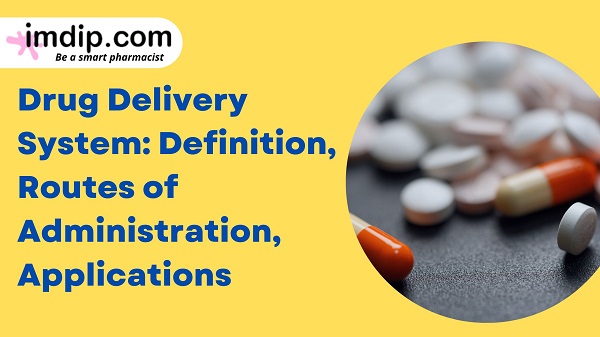
Definition of Drug Delivery Systems:
Drug delivery systems are designed to enhance the effectiveness and safety of medications by controlling the rate, time, and site of drug release in the body. These systems allow for the targeted delivery of drugs to specific sites, which can improve drug efficacy and reduce side effects. In this article, we will explore the various types of drug delivery systems and their applications.
Related Article: Targeted Drug Delivery System- Characteristics, Advantages, Disadvantages, Types, Applications
Types of Drug Delivery Systems (Routes of Administration):
- Oral Drug Delivery Systems: This is the most common route of drug administration, and it involves the use of tablets, capsules, and other forms of oral medication. Oral drug delivery systems are advantageous because they are easy to use and have a wide range of applications. However, they are limited by factors such as drug solubility, stability, and absorption.
- Injectable Drug Delivery Systems: This involves the use of needles and syringes to administer drugs directly into the bloodstream or a specific site in the body. Injectable drug delivery systems are used in emergency situations, for pain management, and for the delivery of biologics.
- Topical Drug Delivery Systems: This involves the use of creams, ointments, and patches that are applied to the skin to deliver drugs. Topical drug delivery systems are used for local pain relief, skin disorders, and transdermal drug delivery.
- Inhalation Drug Delivery Systems: This involves the use of inhalers and nebulizers to deliver drugs to the lungs. Inhalation drug delivery systems are used to treat respiratory disorders, such as asthma and chronic obstructive pulmonary disease (COPD).
- Implantable Drug Delivery Systems: This involves the use of devices that are implanted into the body to deliver drugs over an extended period. Implantable drug delivery systems are used for the treatment of chronic conditions, such as diabetes and pain management.
Some drug delivery systems do not have a defined route of administration.
- Liposomes are spherical, microscopic vesicles composed of a lipid bilayer that can encapsulate both hydrophilic and hydrophobic drugs. They can be used to deliver drugs to various sites in the body, including tumors, due to their ability to pass through small blood vessels and selectively accumulate in target tissues. Liposomes can also protect drugs from degradation, prolonging their half-life and reducing toxicity. They can be administered intravenously, intramuscularly, or subcutaneously, making them a versatile drug delivery system.
- Dendrimers are branched, highly branched, tree-like molecules that can encapsulate drugs within their cavities. They can be used for targeted drug delivery to specific cells or tissues due to their small size and high surface area-to-volume ratio. Dendrimers can also enhance drug solubility, stability, and bioavailability. They can be administered intravenously, orally, or topically, depending on the drug and its intended use.
- Nanoparticles are small, sub-micron-sized particles that can encapsulate drugs or attach drugs to their surface. They can be used for targeted drug delivery to specific cells or tissues, as well as for sustained drug release. Nanoparticles can be made from various materials, such as polymers, lipids, and metals, and can be administered intravenously, orally, or topically.
- Cyclodextrins are cyclic oligosaccharides that can encapsulate hydrophobic drugs within their cavity. They can enhance drug solubility and bioavailability, as well as protect drugs from degradation. Cyclodextrins can be administered orally, intravenously, or topically.
Applications of Drug Delivery Systems:
- Cancer Treatment: Drug delivery systems are used to deliver chemotherapy drugs directly to cancer cells, reducing the side effects of the drugs and improving their efficacy.
- Pain Management: Drug delivery systems are used to deliver pain medication directly to the site of pain, reducing the need for systemic pain medication and reducing side effects.
- Diabetes Management: Implantable drug delivery systems are used to deliver insulin to patients with diabetes, reducing the need for multiple daily injections and improving glucose control.
- Gene Therapy: Drug delivery systems are used to deliver genes to target cells, which can be used to treat genetic disorders.
- Vaccines: Drug delivery systems are used to deliver vaccines directly to immune cells, improving vaccine efficacy and reducing the number of doses required.












.png)
